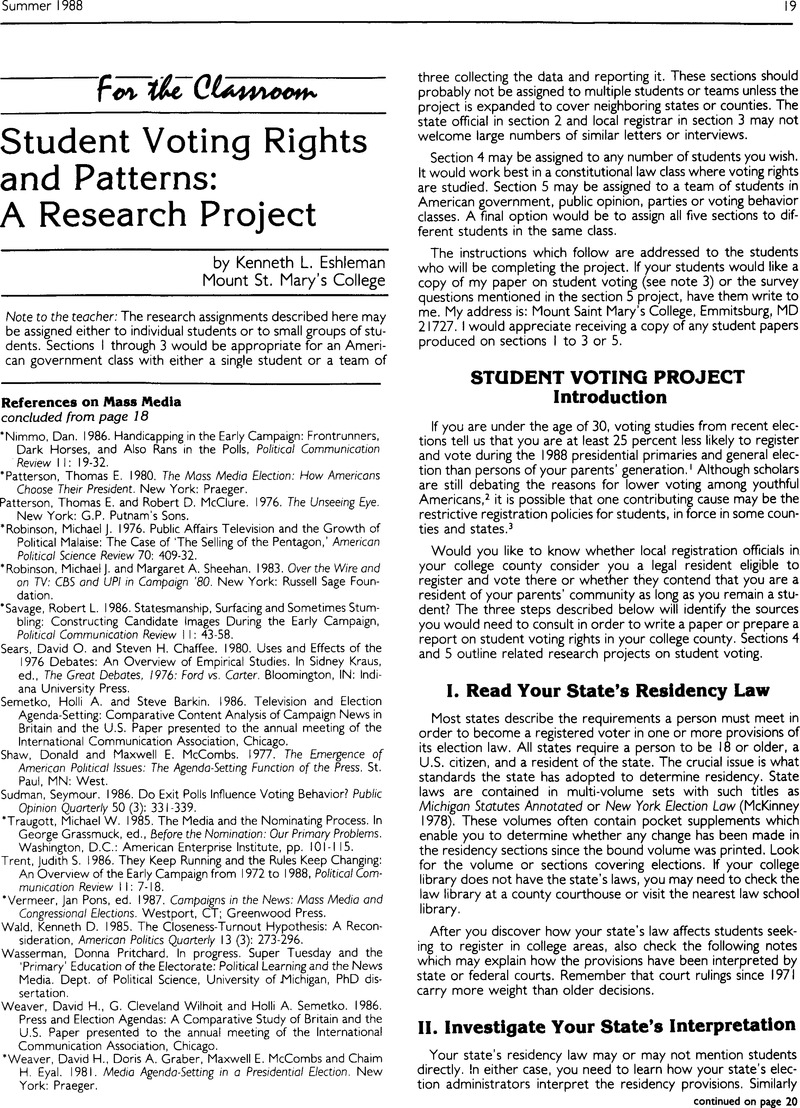No CrossRef data available.
Article contents
Student Voting Rights and Patterns: A Research Project
Published online by Cambridge University Press: 30 October 2015
Abstract

- Type
- For the Classroom
- Information
- Copyright
- Copyright © American Political Science Association 1988
References
Notes
1. Abramson, Paul R., Aldrich, John H. and Rhode, David W., Change and Continuity in the 1984 Elections, rev. ed. (Washington, D.C.: CQ Press, 1987), 108. Surveys suggest that students vote at a somewhat higher rate than non-students of similar age and education (see source listed in note 2)Google Scholar.
2. Wolfinger, Raymond E. and Rosenstone, Steven J., Who Votes? (New Haven: Yale University Press, 1980), 55–58Google Scholar.
3. Eshleman, Kenneth L., “Where Should College Students Vote? State Laws, Registration Practices and Turnout,” paper presented at the annual meeting of the American Political Science Association, Chicago, September 4, 1987Google Scholar.
4. Exact titles vary from state to state. In Texas, for example, the tax assessor-collector registers voters.
5. Excerpts of major Supreme Court opinions may be found in numerous constitutional law texts or casebooks. Two such books that include all three cases are Constitutional Rights and Liberties, 5th ed. by Lockhart, William B., Kamisar, Yale, and Choper, Jesse H. (St. Paul: West Publishing, 1981)Google Scholar, and American Constitutional Law, 2nd ed. by Rossum, Ralph A. and Tarr, G. Alan (New York: St. Martin's Press, 1987)Google Scholar.
6. If you have never looked up a court opinion in United States Reports, the first number after the case name is the volume number and the second number is the page in that volume where the case begins. The Dunn opinion, for example, is in volume 405 starting at page 330.
7. Students are currently fighting procedures used in Onondaga County (Syracuse, N.Y.) where local commissioners require students to complete a special questionnaire. In 1987, 800 of I 100 students were denied registration in the county, according to attorney Randall Weiner who is assisting the students (interview, November 20, 1987) and Richard Watts, a graduate student who has led student registration efforts in the county.
8. The Index to Legal Periodicals from 1970 to the present lists the articles under “elections.” Large university and law school libraries normally have many law reviews.
9. Major authors include Claude, Richard, The Supreme Court and the Electoral Process (Baltimore: Johns Hopkins Press, 1970), chapters 7 and 11Google Scholar; Dixon, Robert G. Jr., Democratic Representation: Reapportionment in Law and Politics (New York: Oxford University Press, 1968), 146–148 and ch. 11Google Scholar; McKay, Robert B., Reapportionment: The Law and Politics of Equal Representation (New York: Twentieth Century Fund, 1965), 166–186Google Scholar; Berger, Raoul, Government by Judiciary: The Transformation of the Fourteenth Amendment (Cambridge, Mass.: Harvard University Press, 1977), chapters 5 and 10Google Scholar; and Elliott, Ward E. Y., The Rise of Guardian Democracy: The Supreme Court's Role in Voting Rights Disputes, 1845–1969 (Cambridge, Mass.: Harvard University Press, 1974), chapters 5 to 7CrossRefGoogle Scholar.
10. The analysis of student turnout in Who Votes? (see note 2) is based on a Bureau of the Census survey which collects information from parents of students, counts dormitory students at their parents' residences, and does not ask where students vote. (The claim in Who Votes? on page 116 that dormitory students are “left out” of the survey is an error according to Jerry Jennings, Bureau statistician.) The American Council on Education and U.C.L.A. conduct an annual poll which measures political attitudes, but the survey normally includes only freshmen and does not usually ask about registration and voting.
11. Examples of such guides are: Bailey, Kenneth D., Methods of Social Research, 3rd ed. (New York: Free Press, 1987), chapters 5 and 8Google Scholar, and David, and Nachmias, Chava, Research Methods in the Social Sciences, 3rd ed. (New York: St. Martin's Press, 1987), chapters 8 and 16Google Scholar. Earlier editions of these or similar works should also prove helpful.




